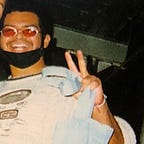Significant Expressions in Art
Communication is neccesary. Langauge is not. Language nevertheless serves its function — to express one’s mental content.
There are countless examples of communication amongst beings and entities. Animals communicate, yet, there’s no language. There’s communication between atoms — a communication we can’t quite comprehend. We may understand the mechanisms that allow for communication between molecules and atoms, but alas, never understand in what way they communicate.
For example, I can imagine a removed observer, looking on and studying human communication. The observer would learn the mechanism by which we communicate, namely, the produced vocalizations from our mouths. Such a removed observer would not be able come to the conclusion that there are indeed systems in place, several systems, differing by locale and context. And to add a further level of complexity, the observer would not be able to make sense of the facial and physical gestures. The intonations, the emphasis, the vernacular exclusive to certain peoples, cultures, and groups.
So, I repeat, the observer cannot make a logical leap from the observed mechanisms of human communication to a systematic and coherent form of communication, known to us participants, as language.
This must be so with other entities and beings alike. We can study animals and know there must be some form of communication that allows them to transfer mental content amongst themselves. However, we wouldn’t and shouldn’t dare to call such communication a language.
Therein lies a problem, oftenly ignored by the public. One confuses communication and language as one in the same. Where I have now attempted to show that language is a unique phenomena, exclusive to human beings.
With how intensely complicated language is, we mustn’t be quick to say that it is perfectly suited for all our needs. As I have pointed out, with how confusing each language is — all games within games— it’s no wonder we tend to misunderstand one another.
But as I mentioned in the beginning, communication is necessary, and language is but only one medium to communicate.
For what is language, but another art form? Language, similar to art, has a spatial and temporal dimension. And art, similar to language, is intensely convuluted. Yet, I’d argue that art is best at communicating significant matters. That is, it’s best suited for significant expression.
Although language has evolved from simple guttural sounds, and there is a plethora of words to choose from in order to properly express one’s mental content — the millions of words are all but useless synonyms.
If one attempts to describe their love, they may be inclined to associate it with feelings of adoration, zeal, and commitment. Yet, those words will need further descriptions, and so on. Thus, all words can be eventually reduced — with no underlying basis supporting them besides convention and relation to other presumptuous truths — in essence, words are utterly empty.
What of art? Art, much like language, also has spatial and temporal dimensions allowed to it. Here, I am not striclty limiting myself to visual arts, but all forms of art. Music, film, architecture, dance, acting, pottery, etc. It’s hard to describe how art communicates. But we know it does.
When the artist creates, I believe the intention, consciously or unconsciously, is to first and foremost express. The expression comes in many forms; for example, perhaps one creates for financial gain, thus the form of art is the expression of need. And at the same time, perhaps they also create for another person, or for leisure, or for passion. Works of art can take many forms all at the same time. The totality of these forms, conscious or unconscious ideas that pass through the artists’ mind, is the truth of the work. The truth of the work is the significant expression present in all created works.
It is now apparent that art can communicate many times over the truth of the work than language could ever. This is truly more efficient than whatever word and language can accomplish in hundreds of pages.
Art can take several forms, mix and match sentiments and ambitions, and blend them into a singular work. The work does not communicate explicitly, but implicity. An artist in the process of their creation will have innumerable sentiments and sensations; for one to communicate all thereof through language would take far too long and be needlessly wordy. And even if done correctly, miscommunication would arise.
That isn’t to say art does not have its own fair share of miscommunication, but instead it is known as misinterpretation. However, unlike language, misinterpretation does not reduce or strip the work of its significant expression. With the amount of transient ideas that surface and subsurface an artwork, it’s quite possible that whatever another believes is the significant expression of said artwork, that idea must be implicitly held within it thereafter, even though it may have not been apart of the artist’s mental content (sentiments and sensations). And so, it appears that art does not reduce significant expression, rather it is additive and receptive. Art collects unsaid truths from both sides of the work. The artist and all the others. Art holds within itself all that can be said between artists and members.
Artists, whether they believe it or not, make manifest the significant expressions.The truth of the sentiments and sensations is unspoken, yet expressed. It is as if art is a reality all in its own.And much like our own reality, complex, but not reductive. Receptive and additive of all knowledge and truths between subjects and objects. Artist and the others. Within each reality, there is all that can and must be said. Art communicates the most signficant expressions that are otherwise never known to us in waking life.
